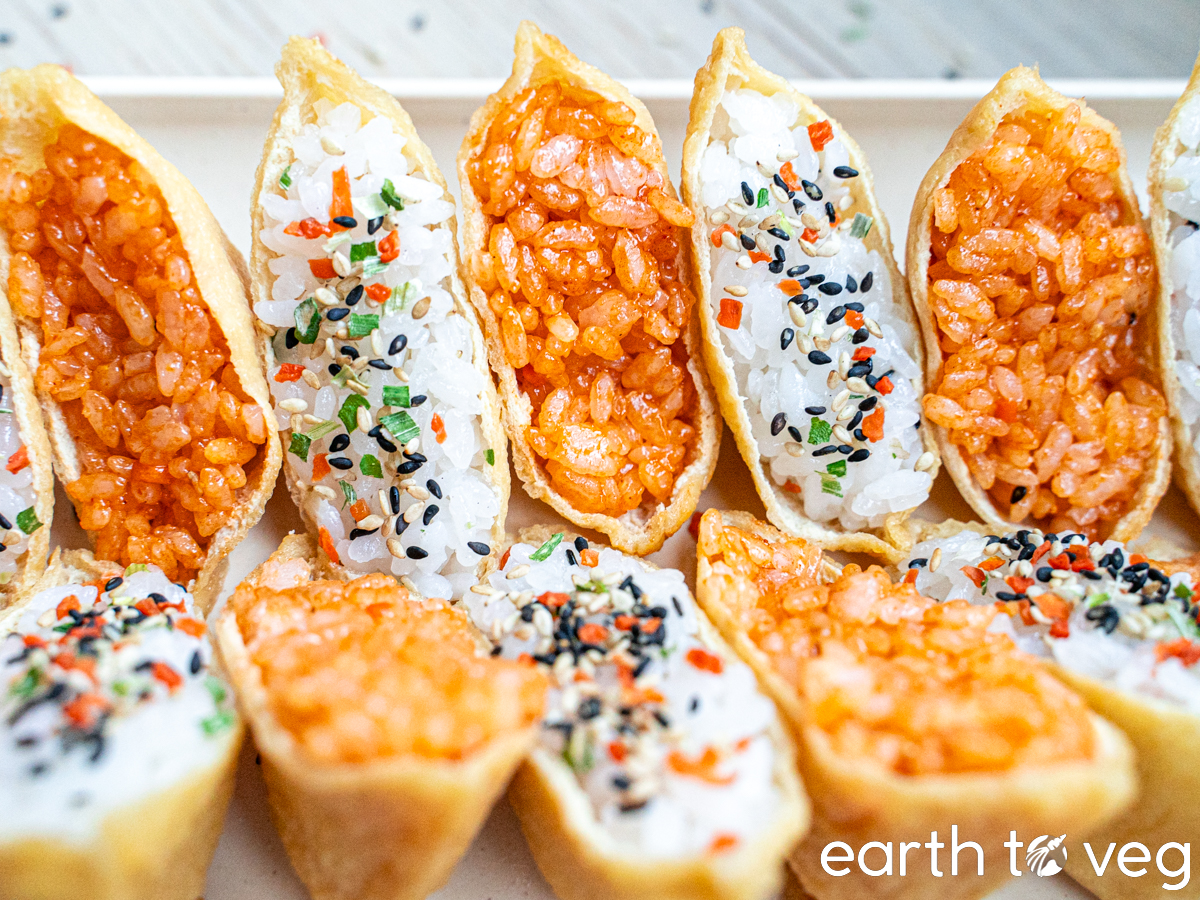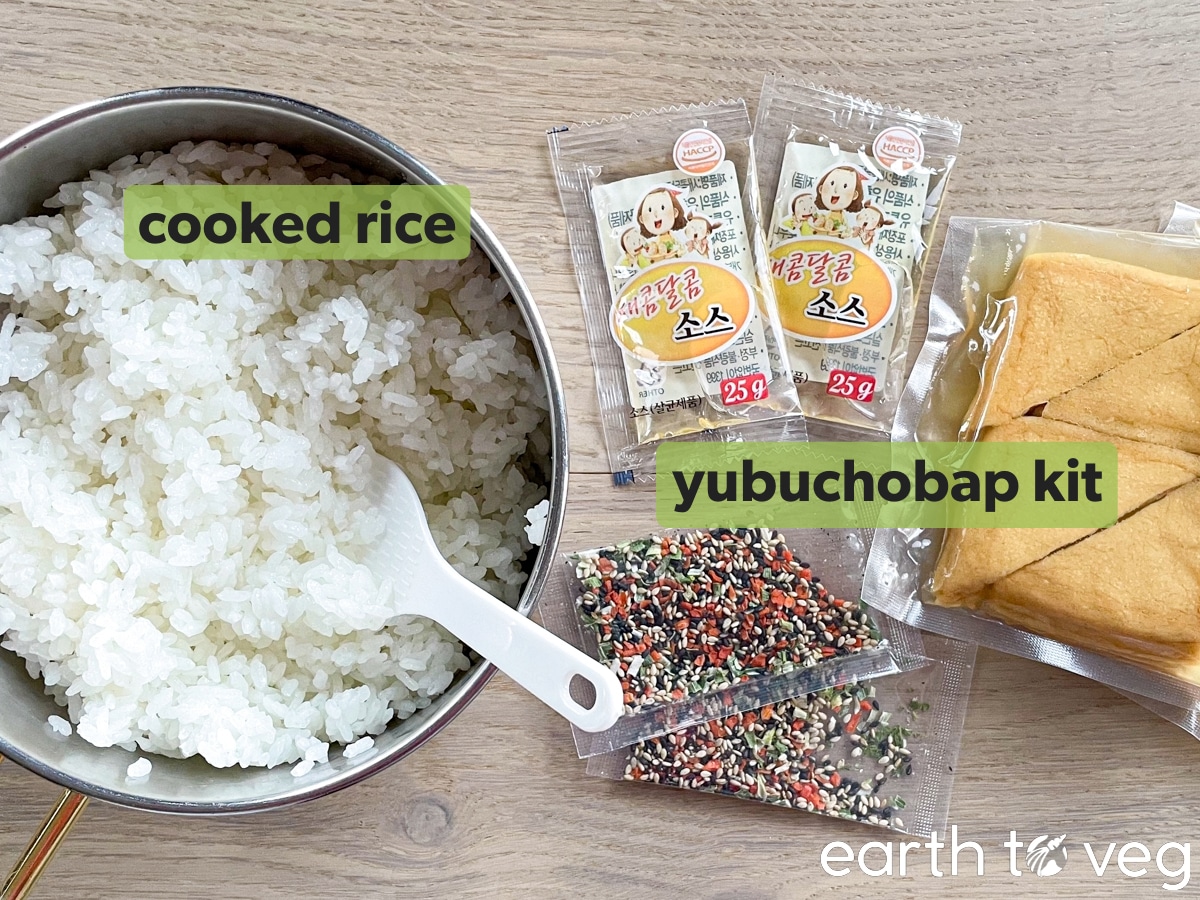Yubuchobap (유부초밥) is a Korean recipe of fried bean curd pockets stuffed with sushi rice. It’s basically the Korean version of inari sushi. Sweet, savoury, sour, and addictive! I recommend making more than you think you’ll need, because I guarantee you’ll end up eating some as you assemble them along the way.

Why Make Your Own Yubuchobap?
- Customizable: The beauty of homemade yubuchobap is that it’s so versatile. You can add your own mix-in’s and toppings. I love to add buldak sauce and sesame seeds to my Korean bean curd pockets.
- Cheap: It’s way more affordable to make yubuchobap at home. For example, at one of my favourite pocket sushi shops, Pocket Holic, a plain tofu pocket costs $2.25. Meanwhile, I can buy a whole yubuchobap kit, which makes 16 pieces, for $4.99 at the Korean store.
- Easy: Yubuchobap has become one of my go-to quick dinner sides. Besides steaming the rice, there’s no other cooking, and it’s fun to get the family involved to help you fill all the pockets. It’ll be ready to eat in no time.
Yubuchobap vs Inari
Yubuchobap and Inari are very similar, and they’re often used interchangeably. There are a few small differences, though.
Yubuchobap is the Korean term: yubu means “bean curd skin,” cho means “vinegar,” and bap means “rice.” So: bean curd vinegar rice.
Inari or Inarizushi is the Japanese word for the same dish. Inari Ōkami is the name of a Japanese kami (spirit) in Japanese mythology who is believed to love fried tofu.
One key difference between the two is that the rice for yubuchobap is often filled with minced vegetables like carrots, broccoli, and scallion. On the other hand, inari is topped with Sashimi, Furikake, and other garnishes.
Another difference (though this is not always the case): Yubuchobap pockets are triangular while inari pockets are rectangular.
What You’ll Need

A few important notes on some of the ingredients used in this Yubuchobap recipe:
Cooked Rice: Ideally use a short-grain rice, like for sushi. Koshihikari is best. You can follow my 4-Step Stovetop Rice recipe to cook the rice to perfection.
Yubuchobap Kit: You can find this at Korean grocery stores. These kits contain three items: vinegar-based liquid seasoning, packets of dried minced vegetables, and the all-important fried tofu pockets.
For a full list of ingredients and quantities, refer to the recipe card at the bottom of this post.
Flavour Variations
- Option 1: The traditional flavours for yubuchobap are contained in the yubuchobap kit. The rice is seasoned with a mixture of vinegar, sugar, salt, and sometimes mirin. It’s the same ingredients used in sushi rice. Then, finely minced vegetables and sesame seeds are mixed in.
- Option 2: Samyang, the spicy Korean noodle brand, sells their infamous Buldak Hot Chicken Flavour Sauce in a bottle so you can add it to any recipe, not just noodles (although I do have a Buldak Glass Noodles recipe). Even though it’s chicken flavoured, the sauce is vegan-friendly. I squeeze some into the sushi rice to make it spicy and flavourful.
Btw, I’m not being sponsored to say this. We’re just big fans of this buldak sauce. Kevin and I both think that it tastes 🔥FIRE🔥 when paired with yubuchobap. #punintended)
Step-by-Step Process

Option 1: Empty the vinegar sauce and dried seasoning packets into the rice while still hot. Mix well. Follow the directions on the kit to see how much rice to use per packet of vinegar sauce. Generally, it’s about 1 cup of cooked rice per 1 tbsp of sauce.

Option 2: Mix buldak hot sauce into the hot rice. You can add as much sauce as you want depending on how spicy you like it. You can also combine Options 1 and 2 by adding the hot sauce in addition to the traditional flavourings in the yubuchobap kit.

Assemble: Open up each fried tofu pocket. Using a spoon or small rice paddle, stuff the seasoned rice into each pocket. It’s as simple as that!
Generally, 1 large yubu pocket (weighing 15g) will take about 25–30g of cooked rice. However, tofu pockets come in all different sizes so it’s best to read the directions on the package. They will tell you how much rice to prepare.
Make Ahead & Storage Tips
Fridge: Keep yubuchobap refrigerated for up to five days.
Freezer: Freeze in an airtight container for up to three months. Preferably use a ziploc bag where you can squish all the air out, to prevent freezer burn. Defrost in the fridge overnight, or on the counter at room temperature for a few hours.
Reheating: Once chilled, the rice will get hard. Warm it up in the microwave to bring it back to a plump and chewy texture.
What to Serve with Yubuchobap
Recipe FAQs
Yubuchobap (유부초밥) is a popular Korean dish that consists of seasoned rice wrapped in sheets of fried tofu skin. It’s similar to the Japanese inarizushi. Yubu (유부) refers to the fried tofu skin, which is shaped into pockets and used to hold the rice. Chobap (초밥) means sushi rice, with cho meaning “vinegar” and bap meaning “rice.” This sushi rice is the traditional filling for yubuchobap.
Yes, yubuchobap is typically vegetarian and vegan-friendly. At its simplest, it’s made of rice and tofu pockets. The tofu pockets are typically seasoned with all-vegan ingredients such as vinegar, salt, and sugar or syrup. To level up, you can add fillings such as diced vegetables, hot sauce, pickled radish, furikake, and sesame seeds. It is often served with a dipping sauce or soy sauce for added flavor.
Tofu skin in Korean is known as 두부껍질 (dubu kkeobjil), and the fried version is called 유부 (yubu). Both terms refer to tofu skin or tofu sheets, which are made from the skin that forms on the surface of soybean curd (tofu) when it is being cooked or processed. These tofu skins are often used in Korean cuisine to make dishes like yubuchobap (stuffed tofu pockets).
Yubuchobap tastes sweet, sour, and savoury. The rice itself is sweet and sour, like sushi rice, while the fried tofu pockets are seasoned with an umami-rich soy-based sauce. Sometimes raw or cooked minced vegetables are added, which add a fresh taste and some crunchy texture. Overall, yubuchobap is a satisfying combination of savory umami, subtle sweetness, and a variety of contrasting textures, making it a delicious and customizable Korean dish.
More Korean Recipes

Recipe Card
Did you make this recipe? Please consider leaving a rating below to let me know how you liked it.
You can also take a picture and tag me on Instagram @earthtoveg, I will shout you out in my Stories!

Yubuchobap (Korean Bean Curd Pockets)
Use Imperial/Metric buttons below to toggle between volume vs weight measurements. I recommend weighing out your ingredients for best results.
Equipment
- Spoon or small rice paddle
Ingredients
- 1 batch Cooked White Rice = 3 cups cooked rice
- 1 yubuchobap kit approx. 16 to 20 pockets; see Note 1
- 1 to 2 tbsp buldak hot sauce *optional
Instructions
- Empty the vinegar sauce and dried seasoning packets into the rice while it’s still hot and mix well (see Note 1).
- Optional: To make spicy yubuchobap, mix buldak hot sauce into the rice. You can add as much sauce as you want depending on how spicy you like it.
- Open up each fried tofu pocket. Using a spoon or small rice paddle, stuff the seasoned rice into each pocket. It’s as simple as that!
Notes
- Yubu Pockets: Generally, 1 large yubu pocket (weighing 15g) will take about 25–30g of cooked rice. However, tofu pockets come in all different sizes so it’s best to read the directions on the package. They will tell you how much rice to prepare.
- Seasoning Rice: Follow the directions on the kit to see how much rice to use per packet of vinegar sauce. Generally, it’s about 1 cup of cooked rice per 1 tbsp of sauce.

These were delicious!! You were right, definitely had to make more than I expected because a few mysteriously disappeared on their way from the kitchen to the dining room 😋
So mysterious right? 👻 Happens every time…